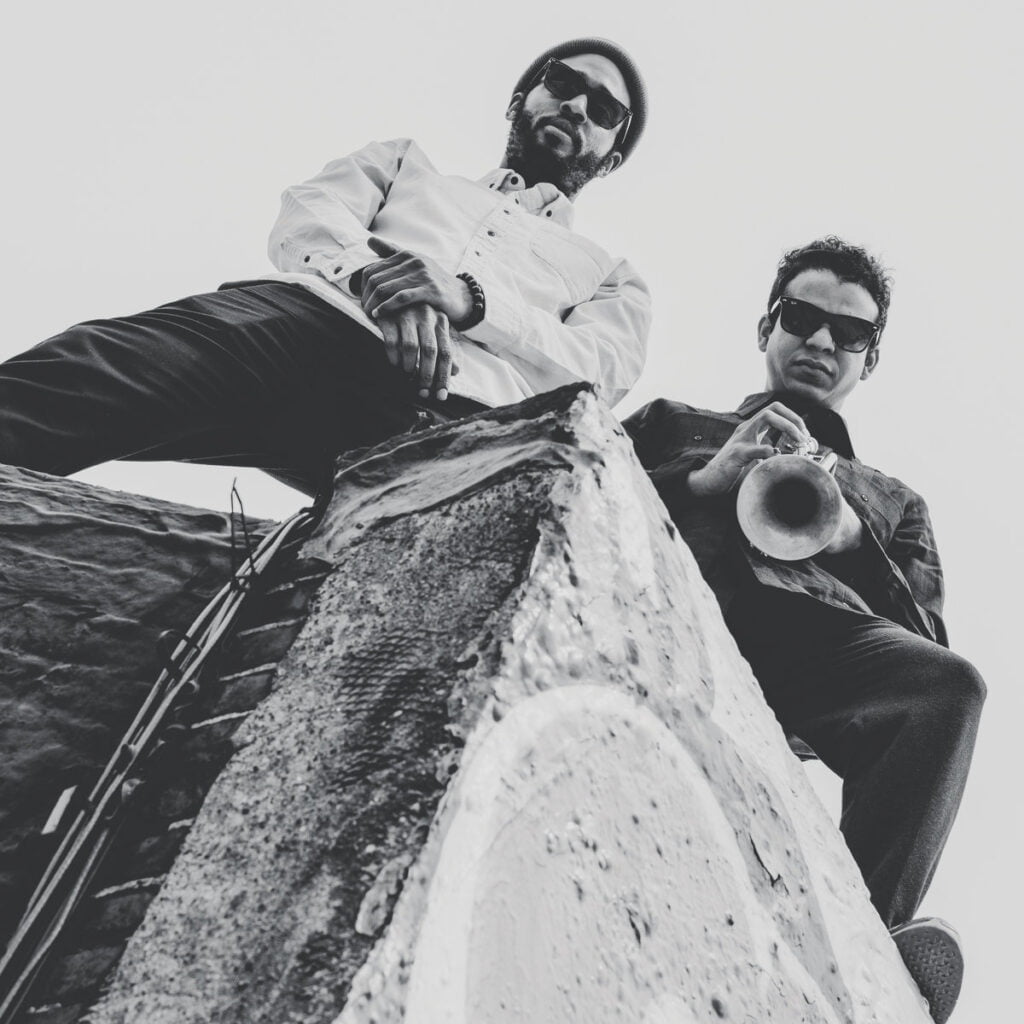Description
“Heritage of the Invisible II” follows Navarro and Holmes’s rise to prominence as members of free jazz collective Irreversible Entanglements. In March of 2020 in “The Nation” writer Marcus J. Moore said “Irreversible Entanglements’ fearless music takes to task the police, American politics, capitalism, and racism.” The revolutionary ethos that drives Irreversible Entanglements is no less present in Navarro and Holmes’s duo work, though their duo finds them much more wholeheartedly and jubilantly embracing their Latin and Afro-Caribbean foundations.
Aquiles Navarro was born in Toronto during a time of great, political upheaval in his family’s native home of Panama. Dangers surrounding the reign of Manuel Noriega and the subsequent U.S. invasion of 1989 prompted the Navarro family’s exit, returning years later to Panama City in 1997. Latin folkloric music was fastened deeply to the family paradigm. After studying with Panamanian trumpeter Victor “Vitin” Paz (Fania All-Stars) and Panamanian-American composer/saxophonist Carlos Garnett (Miles Davis, Pharoah Sanders), Navarro moved to Boston to study at the New England Conservatory (NEC). Before the semester had even begun, a friendship had kindled between him and another incoming new student, Tcheser Holmes.
Since a young age, Tcheser Holmes naturally wove into the fabric of a tight-knit Pan-African community in Brooklyn centered around the spiritual organization, Ausar Auset Society, and his family’s dance company, The Bennu Ausar Dancers. From early on, Holmes remembers “playing and viewing music purely as a source of celebration and achievement.” As a teenager he enrolled in the Manhattan School of Music’s Precollege for pre-conservatory training, and eventually made his way toward NEC.
After their tenure at NEC, both musicians relocated to New York City. “In New York, I’ve been a working musician since day 1,” recalls Navarro. “Tcheser and I played all over the city, from Uptown to all over Brooklyn, often booking our own gigs.” Dance clubs and subway platforms, The Bowery Poetry Club, the Latin Jazz Big Band at the Nuyorican Poet’s Cafe, and Roberto Roena y Su Apollo Sound in the Bronx – the two musicians developed a wide creative range. “We got familiar with a system where the rhythm is quantified,” says Holmes. “But I feel like we always remained ‘children’ in terms of viewing music. Kobe said ‘Be a Kid.’ We never needed to validate the process.”
In Summer 2014 they traveled to Panama together to perform and record a set of duo improvisations, which they digitally self-released later that year. Back in Brooklyn in 2015, Navarro and Holmes performed as a duo at a Musicians Against Police Brutality event, where they shared the stage with the trio of Camae Ayewa (aka Moor Mother), Keir Neuringer and Luke Stewart. The two groups made fast friends, and shortly after, came together to form the collective quintet Irreversible Entanglements. With Irreversible Entanglements they recorded two critically-lauded albums (“Irreversible Entanglements”, released 2017, and “Who Sent You?”, released 2020) across several years of growth and international touring (including performances at Pitchfork Music Festival in Chicago, Le Guess Who? in Utrecht, NL, the Barbican in London, and the Smithsonian in Washington, DC).
In the Fall of 2019 Navarro and Holmes coalesced around the idea of composing new, expanded duo music, and booked two after-hours sessions at Brooklyn’s S1 Studios. “Each tune has a compositional background to it, but improvisation and the telepathy between us remains the main catalyst,” notes Navarro. From this open map, the duo layered samples and electronic elements from Juno 106 and Moog Grandmother synths over their acoustic improvisations, overdubbed contributions from poets, vocalist and instrumentalist friends, and added field recordings of themselves in conversation. To sculpt the mass of sounds they commissioned ada adhiyatma (aka Madam Data, a Philadelphia-based composer/electronicist who they’d met through a joint collaboration with Moor Mother) for a final mix. The resulting album – “Heritage of the Invisible II” – reveals Navarro and Holmes stepping firmly into the limelight of progressive music-making.
The tracks flash by in a rapturous onslaught, crystalizing in incantations by Spanish poet Marcos de la Fuente (an apocalyptic fever dream on “Initial Meditation”), vocalist Brigitte Zozula (the bliss of bustling nightlife on “A Night in NY”), Navarro’s mentor and collaborator Carlos Garnett (the banality of economics on “$$$ /// billete”) and their own musings on friendship and community (the stoned soul picnic of “Plantains”). Of the album’s de facto anthem “Pueblo,” Navarro says “it’s a celebration of life, the coming together of the people, el pueblo, a celebration of who we are, where we come from, it’s our pueblo, our people, a feeling of openness, hope, and a future of unity from el pueblo, the people.” Identifying as active listeners and audience members as well, Navarro and Holmes step back on “M.O.N.K (Most Only Never Knew)” to shine a light on the solo improvisation of pianist/composer Nick Sanders. On the 8-minute duet “NAVARROHOLMES,” the two players reach a summit as they face off in spirited alliance, conjuring visions of legendary free jazz telepathics – Braxton and Roach, Coltrane and Ali, Cherry and Blackwell.
Navarro and Holmes never idle on “Heritage of the Invisible II,” choosing instead to ponder their origins in a devout charge of ecstatic cooperation. Meditating on the unseen constructive forces of culture and rhythm as a cadence encoded in one’s heritage, with “Heritage of the Invisible II” they share a volume of their story in rich color – a brilliantly imagined testament to generations of memory, creation and existential joy.

